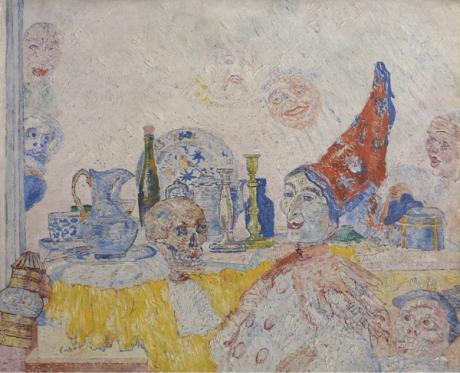Collectors’ Favorites
1994 - Film & Video (Film & Video)
Jennifer Bornstein
Collectors’ Favorites is an episode of local cable program from the mid-1990s in which ordinary people were invited to present their personal collections—a concept that in many ways anticipates current reality TV shows and internet videos. When it comes her turn to “perform,” Bornstein displays mundane and disposable—but elaborately archived or framed—consumer objects such as coffee lids, plastic straws, candy wrappers, and product labels. Through the medium of public broadcasting, then, she makes visual the frequently overlooked but massive cultural penetration of advertising, and its proliferation of “throwaway culture” via images. Further, Bornstein suggests that within a massive and mercurial social network that often places value arbitrarily, any worthless mass-market products can be turned into coveted objects via absurd relations and vice versa.
Jennifer Bornstein’s works range from performance, conceptual photography, film, drawing, and etchings to curatorial practice. By foregrounding the self-constructed nature of narrative and subjectivity, Bornstein’s practice is a constant rethinking of relations, both social and historical—but not so much in terms of negation and rupture, but rather connection, mutuality, and reintegration.
Colors:
Related works featuring themes of: » Bedrooms and Bathrooms, » Color Photography, » Contemporary Conceptualism, » Contemporary Participation, » American
» see more

© » KADIST
Allan McCollum
1982In the work titled The Glossies (1980), an affinity for photography manifested itself before McCollum actually began to use photography as a medium...

© » KADIST
Julieta Aranda
2016The video Swimming in rivers of Glue is composed of various images of nature, exploring the themes of exploration of space and its colonization...
Other related works, blended automatically
» see more

© » KADIST
Allan McCollum
1982In the work titled The Glossies (1980), an affinity for photography manifested itself before McCollum actually began to use photography as a medium...

© » KADIST
Piero Golia
2007Golia’s Untitled 3 is an installation in which a mechanical device is programmed to shoot clay pigeons that are thrown up in front of a white wall...

© » KADIST
Mungo Thomson
2010In Thomson’s Untitled (TIME) , every front cover of TIME magazine is sequentially projected to scale at thirty frames per second...
Related works sharing similar palette
» see more

© » KADIST
Gan Chin Lee
2019In Studies of Chinese New Villages II Gan Chin Lee’s realism appears in the format of a fieldwork notebook; capturing present-day surroundings while unpacking their historical memory...

© » KADIST
Jao Chia-En
200930 Proposals of Flag explores the relationships between signs, meanings, aesthetics, and nations...

© » THEARTNEWSPER
James Ensor: series of anniversary shows to reveal ‘the man behind the mask’ Art market Museums & heritage Exhibitions Books Podcasts Columns Technology Adventures with Van Gogh Search Search Exhibitions news James Ensor: series of anniversary shows to reveal ‘the man behind the mask’ Belgium commemorates 75 years since the artist's death with a year-long season of exhibitions and events, often highlighting the lesser known aspects of his work Eddi Fiegel 15 December 2023 Share James Ensor, Pierrot and skeleton in a yellow robe (1893) Photo: Hugo Maertens The Belgian artist James Ensor may be easily recognisable for the macabre faces that so often feature in his works, but a major new season of exhibitions and events in his home country aims to reveal “the man behind the mask”...

© » KADIST
Sheroanawe Hakihiiwe
2019Wateoma husipe / Larvas de oruga / Caterpillar larvae by Sheroanawe Hakihiiwe exemplify his most abstract work, where he choses particular elements of a living organism to create his renditions...
Related artist(s) to: Jennifer Bornstein » Loris Gréaud, » San Francisco, » Andrea Bowers, » Ann Hatch, » Bill Timken, » California College, » Dan Fox, » John Baldessari, » Keren Cytter, » Lara Favaretto
» see more

© » KADIST
Loris Gréaud
2004This work refers to the “Dream Machines”, an experimental object invented by the painter and writer Brion Gysin and the scientist Ian Sommerville, and which is composed of a light bulb with light passing through slits in a rotating cylinder...

© » KADIST
Andrea Bowers
2015Bowers’ Radical Hospitality (2015) is a sculptural contradiction: its red and blue neon letters proclaim the words of the title, signaling openness and generosity, while the barbed wires that encircle the words give another message entirely...

© » KADIST
John Baldessari
1991The voids in Baldessari’s painted photographs are simultaneously positive and negative spaces, both additive and subtractive...

© » KADIST
Keren Cytter
“Untitled” is inspired by the movie “Opening Night” by John Cassavetes with Gena Rowlands playing the role of a fallen woman, anguished by her distressed life...
Related works found in the same semantic group
» see more

© » KADIST
Cyprien Tokoudagba
In a style that is unique of Tokoudagba, he evokes the kings, gods and their symbols related to the earth, water, air and fire, usually on a white background...

© » KADIST
Keith Tyson
The work of Keith Tyson is concerned with an interest in generative systems, and embraces the complexity and interconnectedness of existence...




